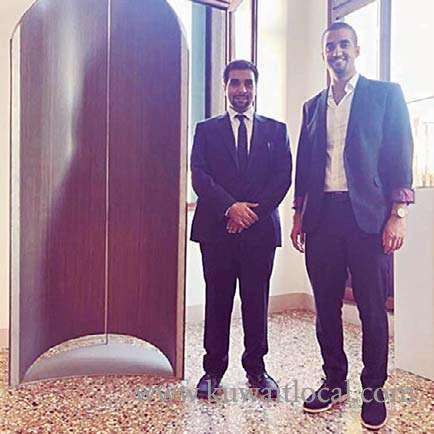Latest News
- Kuwait-Jordan Durra Field Joint Statement Rejected By Iran
- GTD Cracks Down On Vehicle Noise Pollution In Sulaibiya
- Mystery Of Dead Fish At Shuwaikh Beach Sparks Urgent Action
- MEW To Complete Links With The Interior And Justice Ministries B...
- 8 Expats Jailed For Bribing An Officer To Obtain Driver's Licens...
- Weekend Weather Is Expected To Be Hot
- From Tomorrow, Traffic Diversion On Third Ring Road
- Ministry Of Health Refute Rumors On Non-availability Of Antibiot...
- Amir Of Kuwait And Jordan King Renew Commitment To Regional Secu...
- 37 Arrested With Narcotics And Firearms
- Outrage Over Candidate's Arrest
- Six Stores Shut Down In Jahra For Selling Fake Goods
Architect Jassim Al- Nashmi Represented Kuwait At Venice Design 2018

Architect Jassim Al- Nashmi represented Kuwait at Venice Design 2018, an annual international design exhibition, with his design of ‘The Traveling Mihrab’, a contemporary architectural element rooted in Islamic culture, interplaying with the diversity of pieces in the exhibition in a cohesive manner.
The Venice design exhibition was launched by a private viewing on May 24-25 at Palazzo Michiel in Venice, Italy, in the presence of the Second Secretary and the Chargé d’Affaires of Kuwait’s consulate in Italy alongside reporters and other participating artists.
The exhibition which is open to the public from May 26 and will continue for six months. Jassim AlNashmi is an architect, artist and furniture designer who was invited by the GAA Foundation to participate in Venice Design.
The Foundation curators were drawn to the idea of the portable Mihrab and approved it to be part of the exhibition representing the State of Kuwait. Mosque architecture is widely understood to be a rectangular or square building with a dome, a minaret, and a mihrab which is seen on the exterior wall as a subtle bump, and which on the interior looks like a cylindrical space carved out of the wall.
Al- Nashmi shares that the idea of deconstructing traditional mosque architecture is a progressive leap past modernism into the contemporary realm, because it keeps the mihrab wall flat whilst animating the space with curvilinear surfaces, and above all, stands as a new furniture archetype that enriches the culture’s visual identity.
The piece also echoes mihrabs from dynasties in the early periods of Islam when travelers would carry a heavy carved wooden mihrab on camelback.
AlNashmi’s design strips down the motif of the mihrab to its bare necessities giving it its minimalist aesthetic making it a lightweight and portable contemporary piece of furniture. It also unites the three monotheist traditions as the mihrab is where Zechariah found Mary (Mariam) praying, and this symbol of the mihrab as a place dedicated for worship is found in all three religious traditions, Al Nashmi pointed out.
The exhibition also features 51 designers from all over the world including Italy, France, The Netherlands, Russia, USA, Argentina, China, Japan, along with an Arab presence from Wael Farran from Lebanon, Nawaf Collective who work between Jordan and UAE, Ziad Qweider, Basel Naouri and Mais al Azab from Jordan
SOURCE : ARABTIMES
Trending News
-
 Kuwait Implements Home Biometrics Services Ahead O...
14 April 2024
Kuwait Implements Home Biometrics Services Ahead O...
14 April 2024 -
 Kuwait Airways Provides Update On Flight Schedule...
14 April 2024
Kuwait Airways Provides Update On Flight Schedule...
14 April 2024 -
 Kuwait Airways Introduces Convenient Home Luggage...
15 April 2024
Kuwait Airways Introduces Convenient Home Luggage...
15 April 2024 -
 Expat Residency Law Amended By Kuwait Ministerial...
20 April 2024
Expat Residency Law Amended By Kuwait Ministerial...
20 April 2024 -
 Two Expats Are Arrested For Stealing From Salmiya...
17 April 2024
Two Expats Are Arrested For Stealing From Salmiya...
17 April 2024 -
 Kuwait Airways Resumes Flights To Beirut And Oman...
15 April 2024
Kuwait Airways Resumes Flights To Beirut And Oman...
15 April 2024 -
 Temperature Increases Cause Electricity Load Index...
21 April 2024
Temperature Increases Cause Electricity Load Index...
21 April 2024 -
 Thief Returns Stolen Money With An Apology Letter...
15 April 2024
Thief Returns Stolen Money With An Apology Letter...
15 April 2024 -
 3 Expats Caught In Salmiya With 213 Bottles Of Loc...
23 April 2024
3 Expats Caught In Salmiya With 213 Bottles Of Loc...
23 April 2024 -
 Ministry Of Interior Denies Social Media Rumors Re...
13 April 2024
Ministry Of Interior Denies Social Media Rumors Re...
13 April 2024












Comments Post Comment